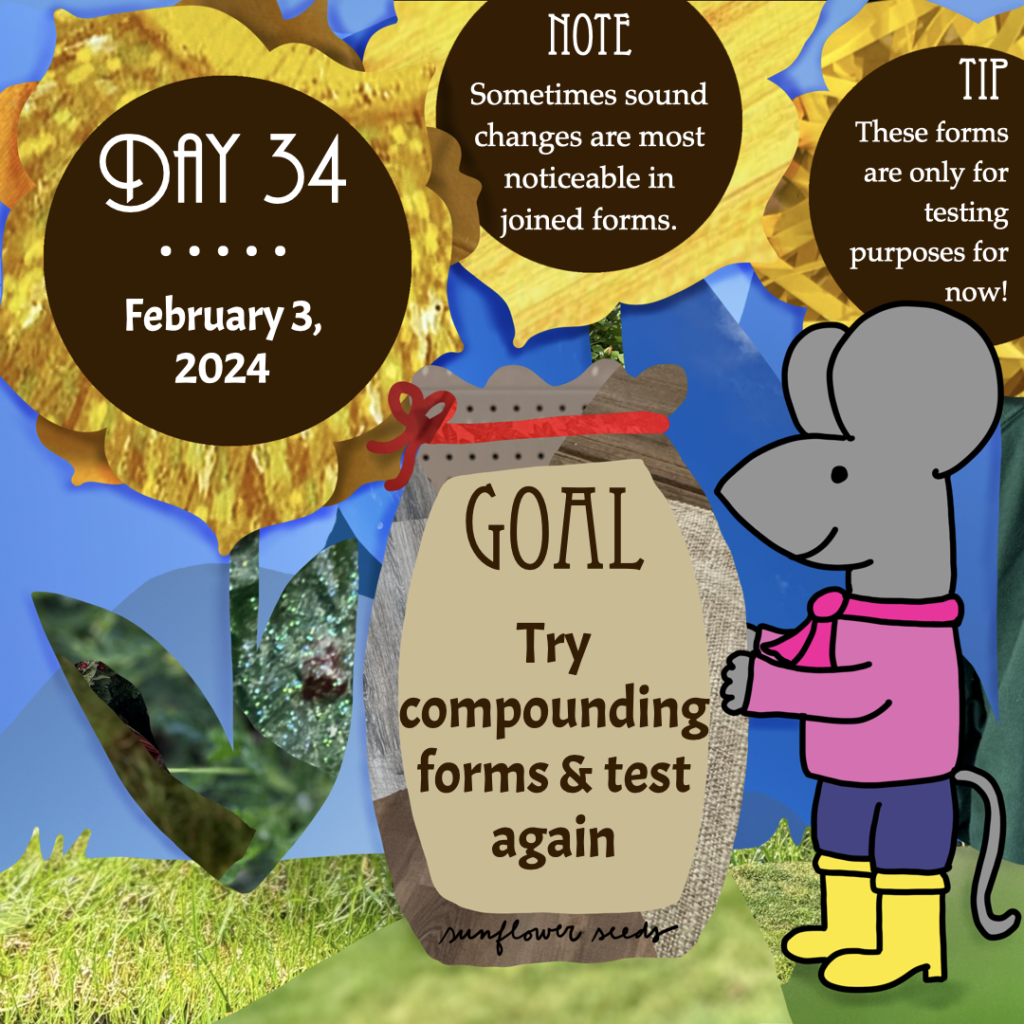
Goal: Try compounding forms and test again
Note: Sometimes sound changes are most noticeable in compound and affixed forms.
Tip: These are not actual compounds yet—they are just for testing purposes.
Work focus: Learn/Brainstorm/Try
This is the last prompt I’ll give you for testing sound changes. (At least, for now it will be. Goodness knows it’s always good to review sound changes down the road…) If you haven’t tried it yet, I encourage you to see what happens when you compound your proto-forms and then apply the sound changes. These compounds don’t need to mean anything or even be used in the language later on—they are simply for testing purposes to see if you like what happens when longer units come together and when sound changes apply across word boundaries.
Another important decision you can consider as you look at compound forms and the effects sound changes have on them is when you might want forms to come together in your language relative to your sound changes. For instance, the other day I showed you what happened when a series of four sound changes were applied to a handful of forms. Here are the sound changes:
- High vowels lower to mid vowels before a nasal coda (i.e. [i] and [u] lower to [e] and [o], respectively).
- When two consonants occur in a row, the second consonant matches the voicing of the first.
- Glottal consonants are deleted.
- An alveolar stop followed by a high vowel palatalizes and becomes an affricate (i.e. [ti] and [di] become [tʃ] and [dʒ]).
Let’s say this language has these compound forms:
*onat + *imi
*koh + *zule
*sol + *fira
If both compounds are old forms in the language, then all sound changes will apply to these forms (as many of the four are applicable, anyway):
| Proto-form | Vowel lowering | CC assimilation | Glottal deletion | Palatalization |
| *onat + *imi | onatimi | onatimi | onatimi | onatʃimi |
| *koh + *zule | kohzule | kohsule | kosule | kosule |
| *sol + *fira | solfira | solvira | solvira | solvira |
That’s assuming both these compounds came together in the language in the proto-stages before any of the sound changes applied. However, let’s say the compounds formed later. Perhaps these compounds were formed between sound changes #2 and #3. If that were the case, then the compounds’ evolution would look like this:
| Proto-form | Glottal deletion | Palatalization |
| *onat + *imi | onatimi | onatʃimi |
| *koh + *zule | kozule | kozule |
| *sol + *fira | solfira | solfira |
The final two compound forms are slightly different because they are not compounded until after the consonant assimilation sound change has applied. Therefore, their forms are unaffected by that sound change, and the initial consonants of the second half of the compound remain the same.
You can even make the situation more complex and have some compounds forming at earlier stages and others at later stages. For instance, in the following table, the cells where the forms are separated by slashes means the compound forms have not yet come together—the words are affected individually by the sound changes but not yet as a combined unit. In this situation, these compounds all formed at different times.
| Proto-form | Vowel lowering | CC assimilation | Glottal deletion | Palatalization | Later stages |
| *onat + *imi | onat / imi | onat / imi | onat / imi | onat / imi | onatimi |
| *koh + *zule | koh / zule | koh / zule | kozule | kozule | kozule |
| *sol + *fira | solfira | solvira | solvira | solvira | sovira |
Here, solvira is the oldest compound, forming in proto-stages of the language. Kozule formed later, between sound changes #2 and #3. The newest compound is onatimi, which formed after all the sound changes took effect and, thus, is not affected as a combined unit by any of the sound changes.
If this interests you, you might take some time to group your sound changes into stages. And then, as you move forward with language creation, you need to decide at what stage a particular combined form came together (this includes compounds and also affixes). Having the sound changes clearly delineated into stages will help you as you create future forms, where you can say something like “this is a Stage 1 compound” or “this is a Stage 2 suffix.” Then you will know what sound changes need to be applied to those forms.
